#oracle cloud apps
Explore tagged Tumblr posts
Text
Oracle HCM Cloud Integration Solutions: Enhancing HR Operations
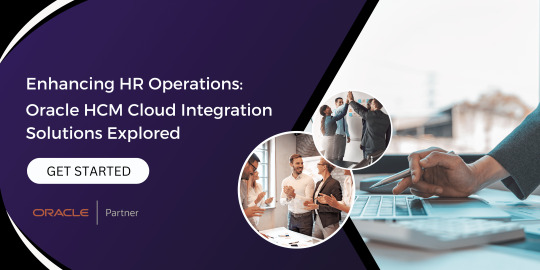
In the fast-paced world of modern business, organizations are constantly seeking ways to enhance their human resources (HR) operations and improve employee management. One solution that has emerged as a game-changer in this regard is Oracle HCM Cloud Integration. At Grey Space Computing, we specialize in Oracle HCM Cloud integration solutions that enable organizations to optimize their HR operations, streamline processes, and drive efficiency throughout the organization.
Understanding Oracle HCM Cloud Integration
Oracle HCM Cloud Integration is a comprehensive platform that allows organizations to seamlessly connect and integrate their HR systems with Oracle’s cloud-based Human Capital Management (HCM) solutions. By integrating disparate HR systems and applications, organizations can centralize their HR data, streamline processes, and gain valuable insights into their workforce.
Key Features and Capabilities
Oracle HCM Cloud Integration offers a wide range of features and capabilities designed to meet the diverse needs of modern HR operations:
1. Seamless Integration:
With Oracle HCM Cloud Integration, organizations can seamlessly integrate their existing HR systems, such as payroll, benefits, and talent management, with Oracle’s HCM solutions.
2. Centralized Data Management:
By centralizing HR data in the cloud, organizations can eliminate silos, improve data accuracy, and gain a comprehensive view of their workforce.
3. Workflow Automation:
Oracle HCM Cloud Integration enables organizations to automate HR processes, such as employee onboarding, performance management, and time tracking, reducing manual effort and improving efficiency.
4. Real-time Analytics:
The platform provides real-time analytics and reporting capabilities, allowing organizations to gain actionable insights into workforce trends, performance metrics and employee engagement.
5. Enhanced Security:
Oracle HCM Cloud Integration prioritizes data security and compliance with robust encryption, access controls and data protection features to safeguard sensitive HR information.
Benefits of Oracle HCM Cloud Integration
The adoption of Oracle HCM Cloud Integration offers numerous benefits for organizations looking to enhance their HR operations:
1. Improved Efficiency:
By streamlining HR processes and automating manual tasks, organizations can improve efficiency and productivity across the board.
2. Enhanced Employee Experience:
With centralized data management and streamlined processes, organizations can deliver a better employee experience, from onboarding to retirement.
3. Greater Visibility:
Oracle HCM Cloud Integration provides organizations with greater visibility into their workforce, enabling them to make data-driven decisions and optimize their HR strategies.
4. Cost Savings:
By reducing manual effort, eliminating data silos, and improving process efficiency, organizations can realize cost savings and maximize their return on investment.
5. Scalability:
Oracle HCM Cloud Integration is highly scalable, allowing organizations to easily adapt and grow as their HR needs evolve.
FAQs
1. What is Oracle HCM Cloud Integration?
Oracle HCM Cloud Integration refers to the process of seamlessly connecting Oracle Human Capital Management (HCM) Cloud with other applications and systems within an organization. This integration allows for the smooth exchange of data and streamlines HR operations.
2. Why is Oracle HCM Cloud Integration important for businesses?
Oracle HCM Cloud Integration is crucial for businesses as it enables them to optimize their HR operations, streamline processes, and improve employee management. By integrating various HR systems and applications, organizations can enhance efficiency and productivity.
3. What are the benefits of Oracle HCM Cloud Integration?
Some benefits of Oracle HCM Cloud Integration include improved data accuracy, enhanced reporting capabilities, simplified compliance management, and increased employee engagement. Additionally, it allows for better decision-making through access to real-time HR data.
4. How does Grey Space Computing specialize in Oracle HCM Cloud Integration?
Grey Space Computing specializes in providing Oracle HCM Cloud Integration solutions tailored to the unique needs of each organization. Our team of experts has extensive experience in implementing and managing Oracle HCM Cloud integrations, ensuring smooth operations and maximum efficiency.
5. What steps are involved in Oracle HCM Cloud Integration implementation?
The implementation of Oracle HCM Cloud Integration typically involves several steps, including planning, design, configuration, testing, and deployment. Grey Space Computing offers comprehensive services to guide organizations through each stage of the integration process, ensuring successful implementation and optimal performance.
Conclusion
In conclusion, Oracle HCM Cloud Integration solutions offered by Grey Space Computing are designed to empower organizations to enhance their HR operations, streamline processes and improve employee management. With features such as seamless integration, centralized data management, workflow automation, real-time analytics and enhanced security, Oracle HCM Cloud Integration provides organizations with the tools they need to succeed in today’s competitive business environment. Contact Grey Space Computing today to learn more about how Oracle HCM Cloud Integration solutions can benefit your organization’s HR operations.
#app developing company#app development#mobile application development#dubai#mobile app company#web app development#oracle hcm cloud integration#Oracle HCM
1 note
·
View note
Text
Revolutionize Your Business with Custom Web Applications
Web application development services encompass a wide range of activities aimed at designing, building, and maintaining web-based applications. These applications can perform a variety of functions and provide services to users over the internet. Here are the key aspects of web application development that techcarrot offer:
1. Consultation and Strategy:
Understanding client requirements and business objectives.
Offering strategic guidance and consultation on the technology stack, platform, and features.
2. Custom Web Application Development:
Building web applications tailored to meet specific business needs.
Utilizing programming languages (such as JavaScript, Python, Ruby, PHP, etc.) and frameworks to develop scalable and secure applications.
3. Front-End Development:
Creating the user interface (UI) and user experience (UX) design.
Implementing responsive design for optimal user experience across various devices.
4. Back-End Development:
Developing server-side logic and database management.
Utilizing server-side languages (like Node.js, Django, Flask, Ruby on Rails, etc.) and database systems (such as MySQL, PostgreSQL, MongoDB, etc.).
5. Database Design and Integration:
Designing and implementing the database architecture.
Integrating databases with the application for efficient data storage and retrieval.
6. API Development and Integration:
Creating Application Programming Interfaces (APIs) for communication with other systems.
Integrating third-party APIs or services for added functionality.
7. Testing and Quality Assurance:
Conducting a comprehensive testing process that includes unit testing, integration testing, and user acceptance testing.
Identifying and fixing bugs and issues is necessary to ensure a reliable and secure application.
8. Security Implementation:
Enacting security measures to safeguard against common web vulnerabilities.
Ensuring secure data transmission and storage.
9. Deployment and Hosting:
Deploying the web application in a hosting environment.
Configuring server settings and ensuring the application is live and accessible.
10. Maintenance and Support:
Providing ongoing maintenance and support services.
Addressing issues, applying updates, and ensuring the application remains compatible with changing technologies.
11. Scalability and Performance Optimization:
Optimizing the application for performance and scalability.
Monitoring and addressing performance issues as the user base grows.
12. Upgrades and Enhancements:
Implementing new features or upgrading existing ones to meet evolving business needs.
Keeping the technology stack up-to-date for security and performance reasons.
When seeking web application development services Dubai, Abu Dhabi, and the Middle East, techcarrot would be the ideal partner that aligns with your specific project requirements, budget, and long-term goals.
#oracle partners in dubai#oracle jd edwards#oracle consulting company in dubai#cloud service providers in uae#mobile app development company in abu dhabi#web application development services abu dhabi#mobile app development dubai#mobile app development company in dubai#oracle consulting services in dubai#salesforce implementation company in dubai#web application development company abu dhabi#web application development company dubai#web application development#web application testing#web application security#web application services#web application architecture
0 notes
Text
Tim Drake: Ugly Duckling (dp x dc)
So this is the last day of pride month, and so also the last day of me trying to write as many LGBTQ+ canon dc characters. It’s been fun (and I got to read a whole bunch of comics which was actually much more fun than the first time I’d tried to read those!!)
Now even though this is the end of June, feel free to send an ask if you want me to write a blurb with any character. I make no promises, but I will very much try! (It might take a while especially if I’m in a Tumblr hibernation phase.)
Anyways, for the last day of pride month I wanted to do Tim Drake coz he’s dc’s “it girl” with the gays. I’ve been working on this Dead Tired fic for ages, based on the post about Tim getting turned into a swan and meeting Danny, who as a prince has to give him a kiss to change him back (I can’t find the prompt but it was hilarious so this was my take on it).
Here’s the beginning of the fic:
Red Robin was on patrol duty, while Batman and Robin were following a lead on possible joker safehouses. All in all, It was a pretty quiet night with only two muggings, both low-energy as both perpetrator ran away as soon as a bat-shaped shadow moved.
So Red Robin had spent most of the night chatting with Babs. He was grappling around town, as they started on the new date app they’d both found out Jason was using.
“I told him he can’t put only photos of his motorcycle but- wait I’m getting a call,” Oracle interrupted herself. Tim waited before the earpiece came to life again.
“Sorry to cut this short Red Robin, got a full-attention request from Canary. If you need anything, beep me, and Keep your coms open.”
“Bye, Oracle,” he said, and like that, Red Robin was alone once again.
He stopped on Grand Avenue Station and just let himself take in Gotham. The city was beautiful at night, and Tim was itching for a camera. He seen hundreds of pictures of the city’s skyline but they always managed to be unique. The night sky may always be covered by dark clouds above, but Gotham had its own stars in the lights shinning on top of the skyscrapers. So lost in his thoughts, Tim was, he almost missed the soft noise that sounded behind him. The voice that sounded behind him was harder to miss.
“Wither away so late, Little Red Bird?”
Red Robin turned to see a tall woman standing half in the shadows
“Sorry, can I help you?” Answered the vigilante despite the bad feeling creeping up to him.
“I’d like to know where I can find your guardian,” the woman said, still in the shadows.
“You mean Batman?” He chanced.
The woman nodded and Tim resisted the urge to sigh.If this was another one of Bruce’s ill-advised fling, Tim was going to hack every electronic device the man had to play sex-eds on loops for at least a week.
“He’s busy at the moment.” Then feeling like he shouldn’t assume what the woman wanted Bruce for, he continued. “But if you need any help, I’ll do my best.”
The woman stepped forward, and Tim could see her better. Her face was bare, but her distinctive outfit seemed to indicate she was some kind of vigilante-slash-criminal. The outfit did, in fact, ring a bell in the back of his mind, but it was dim. Tim didn’t tense up, but he did angle his body in a way to accommodate for a better escape through grappling. She continued walking until she was within arm’s reach of Tim, towering over him. She extended a hand to lightly caress his cheek, and Tim went still at the touch.
“Such a kind Little Bird you are,” she said gently. “You know, you remind me of my daughter.” She sighed. “Oh, what pretty children you both are.”
“Thank you,” said Tim as he sidestepped out of the way. “I’m sure she’s a lovely person.”
“Oh she was,” the woman said and through his growing wariness, Tim spared a thought for the girl. “She had dark hair and the fairest skin, just like you. The most beautiful girl in the land some would even say.”
That niggling feeling came back as a feeling of familiarity poked at him once again. “You must’ve been very proud.”
The woman let out an airy laugh before saying playfully/contemplating. “mustn’t I?”
A shiver ran down his back. Alright, there was something wrong with this woman, and Tim wasn’t waiting around to find out what. Not without any information or backup.
“Well, if there’s nothing I can do for you, I really have to get going,” Tim said as he took out his grapple gun. In a second, the gun was ripped from his hand , and he was slammed to the side of the staircase leading up to the roof. He let out a gasp at the impact and his features tensed in pain. The woman hadn’t even touched him.
“Not so fast, Little Bird. We don’t want you going back to the Batman just yet. I’m not ready to make him my Knight yet.”
“Your knight?” Tim managed to get out. He tried to move his arms, but some unseen force was pinning him in place. Shit, that meant he couldn’t reach the comm to send out a distress signal. Hopefully Babs would check in soon.
The woman smiled as she approached him once again. “What better for a Queen, than a Dark Knight?”
And just like that it clicked. “You’re the Queen of Fables.”
“Well look at this, you’ve got the brains and the beauty,” she teased, her voice as smooth as honey.
“What do you want with Batman?” Tim asked though he could guess from previous encounters she had had with the Justice League that the villainess wanted to turn Bruce into a fairytale character of some sort. She’d done the trick on Clark, and twice on Diana, so it was probably Batman’s turn now. So, yes, Tim could guess, But the longer he kept her talking the more time he had to figure out a way out of this.
“I told you, he’ll be a Knight of the Queen,” She extended a hand and tilted Tim’s face up. “Do you know what that would make you Little Bird?”
Most villains assumed the batclan worked like a crime family. So the family of a knight? “Nobility,” Tim guessed, unsure where this was going.
“Exactly.” She smiled, and then she moved. Tim braced for the hit.
Instead of a punch though, he only felt a tingling sensation. Cautiously, he opened his eyes, only for them to grow bigger as he took in his uniform. Or the lack thereof.
He was in something-century clothing, in some sort of frilly shirt and pants, all in white. This was worse than a punch. Then, as the thought hit him, Tim’s hands flew to his face only to come in contact with the silky fabric of a masquerade mask. He sighed in relief, and as he calmed down, he realized he was now free of the force pinning him down.
“The color is for my daughter,” the Queen said. Then, she let her head fall to the side before tracing a line across his forehead and Tim could feel something like a circlet setting down on it. “There you go. Now, it’s perfect. You could practically be siblings.”
“No thanks.,” Tim answered.
The Queen tsked him. “That’s no way to behave Little Bird, has nobody taught you to say thank you when you receive a gift.”
“I don’t want anything from you,” Tim disagreed mildly as he took stock of his weapons. Everything was gone, including the earpiece, which meant Babs had to have been alerted and someone was en route.
The Queen frowned. “I was going to be merciful, for you guardian’s sake, but I no longer feel generous.” She raised her hand and Tim tried to roll away, but the magic beam swerved and hit him in a blinding flash of light.
When he managed to open his eyes once again, the world seemed quite a bit bigger than it had been moments before.
“What did you do to me?” He said. Or tried to say.
Instead a strange squawk echoed and Tim took a step back in surprise. However, he lost his balance and started to fall and as he tried to catch himself with his hand, two large white wings unfolded. He dropped down, which wasn’t as far as he would’ve estimated and laid stiff. He moved his left arm, and a white wing followed suit.
Oh, no. Oh no no no.
A grating laugh interrupted his freak out. “There you are my pretty Little Bird, all better. White really is your colour, don’t you th-“
With a loud hiss, Tim propelled himself towards the woman. Making use of his newfound beak, he pecked and bit everything he could, as he flapped his wings.
“Blasted creature- Get off! Stop it, you despicable, puny-“
Finally she managed to grab Tim and throw him away from her. He landed with a squawk, but managed to get himself back to his feet quickly. “You little/awful brat,” she snarled. “You’ll pay for this!”
But as the Queen threw out her hand, something rippled in the air between them and the magic beam seem to explode midway into a green vortex. Tim’s clumsy attempt at waddling away had him head straight towards it, and it was in vain that he tried to redirect the course. She and Tim made eye contact as the swan-boy tipped right into the swirling green vortex, both of their eyes wide-open in surprise.
Danny was exhausted. He was currently on week one of the full month of Royal Duties he’d promised Clockwork. Being Prince of the Infinite Realm was not all that it was cracked up to be, and that was saying a lot since he had already been expecting it to be awful.
When Clockwork had made the request, Danny had proceeded to freak out about his new status, and then tried to abdicate. It was only the master of time reminding him of all the terrible possible candidate for the throne per rites of combat (such as Vlad) that stopped him from washing his hands of this mess. And now Danny was forced to spend one whole month of his summer vacation in the Ghost Zone to fulfill his duty as a Prince.
He thought it would be some paperwork, maybe a battle or two, nothing too bad, but nooo. Because, of course nothing was easy, Danny had to show up at Events, and be Diplomatic. It was meeting, after meeting, after weird parties that were a mix between Medieval Banquets and Debutante balls.
And worse of all were the marriage proposals. Danny could sorta understand, marrying into royalty was a definite plus for a lot of more powerful ghosts but when they called him a half-breed behind his back, only to smile in his face with a marriage contract in one hand and flowers in the other, that was where he drew the line.
Plus there was also the fact that he was, like sixteen.
Suffice to say, Danny was exhausted and hiding out in Pariah Dark’s old castle as a last resort. It wasn’t his favorite place all in all, but the gardens were absolutely beautiful, which was where he was walking. He was currently headed to the hedge maze, since it was the best way to get rid of any tails he may or may not have.
The maze was nasty if it didn’t like you, and it didn’t like anybody but Danny, and even then, it still tried to take a bite every once in a while. Despite the snaking vines and roots trying to capture anything that moved, the flowers that wailed softly when disturbed or the sharp thorns of the hedge plants themselves, it was still a beautiful place. Uniquely, the closer you got to the centre, the more colorful (and dangerous) everything got, which was why he liked it best.
He reached the centre much quicker than the first time he tried, thanks to the maze actually helping him, and something pale caught his eye right in the middle of the open area, right next to the bench Danny loved to use. As he got closer, he realized it was a swan laying on the floor, seemingly unconscious.
“Oh no,” Danny said as he approached. “What happened to you?”
As if awakened by the sound of his voice, the swan started to shift, its wings twitching and it rose its head groggily. As soon as it clocked in Danny, it let out a surprised squawk, followed by a long hiss as it struggled to move away.
“Hey, hey, none of that, Duckie, you’re ok.” Danny raised his hands placatingly. “I don’t want to harm you, ok? I just want to make sure you’re ok.”
The hiss subsided by a bit, but that may have only be due to the swan managing to get further away.
“Sh, sh, it’s ok,” Danny repeated as he slowly inched forward. The swan stopped hissing but still observed him warily. “I don’t want to hurt you Duckie, but I do think we’d better get you out of this maze.”
Danny took another step, and this time the swan stayed still. “How about bringing you back to my rooms just for now.” The swan hissed louder at the statement. “Don’t worry Duckie, I’m not keeping you prisoner it’s just this maze has been known to eat people. And you’re too pretty to be eaten,” Danny flashed a smile at the swan which had it stare back with a gaze saying really?
“So what do you say, wanna crash at my place?” Danny asked. The swan didn’t move forward but he didn’t move away either.
“Yeah, I wouldn’t trust a guy who talks to birds either,” Danny allowed. “And the place where I’m staying is a little gloomy, so I don’t blame you, but I can’t leave you here. The maze is honestly really dangerous, especially for a nice bird is like you. “
The swan seemed to hesitate before it hesitantly made its way to Danny. Ghost animals were usually smart but the swan seemed to understand English, which made communicating that much easier. Danny smiled and opened his arms. “I can carry you.” The swan just looked at him, with what Danny would’ve thought was a deadpan stare. “It would go much faster.”
If the swan was human it probably would’ve sighed, but instead, its wings just fell a little before it waddled towards Danny and looked up as if to say ‘get on with it’.
Danny smiled and gathered the animal in his arms. “Buckle up,” he said before flying off towards the maze exit, which was accompanied by a low hiss. Making sure there was nobody there to ambush him, Danny made it back to the castle in record time.
“Here we are Duckie.” Danny set the swan back down and it plopped down on the ground and just steadied themselves for a while.
Tim was a swan. He had wings and no fingers, and his feet were webbed.
He was handling it though. By which Tim meant he was shelving the impending panic attack for later when he wasn’t stuck in a swan body.
Ok, so he’d been turned by the Queen of Fables, so there had to be an answer in a fairytale,a way to make him normal again. He knew the ugly duckling story. That had a swan in it, right? He didnt know any other swan stories, except maybe as a dish during the wedding banquet of whichever princess. He vaguely remembered a Barbie movie that had passed on the TV when he was younger but the only thing that came to mind were a scary-looking Troll thing, and ballet. So with lack of better alternatives he was going to go with the ugly duckling. The ugly duckling’s happy ending was reuniting with family, so maybe all he needed was to make his way back to Gotham.
“Are you ok?”
And that was another thing. The guy. The one Tim had at first wanted to get away from. He seemed nice and all, but he also had neon green eyes, and fangs. Unfortunately, while they suited the boy very well, they also marked him as an unknown.
On the other hand, if the glowing portal wasn’t enough of an indication, the green tinge of everything around was clear indicator that Tim wasn’t in Kansas anymore. The guy seemed to want to help him, and having an ally wherever he was could only help.
Tim nodded as best as he could with his long weird neck, and he had to take a few steps to regain balance.
“That’s good,” the boy smiled with his white pointy canine. “How did you end up in the middle of that maze?”
Tim just looks back tiredly. He didn’t know how to even try and explain when he couldn’t say a word and had no opposable thumbs.
“Yeah, sorry.” The boy winced. “Maybe stick to yes or no questions.”
There was a sharp knock at the door that had the boy turning away.
“Prince Phantom!” A voice rung through the door.
Prince?
The newly-dubbed Prince Phantom got up to open the door, “yes, what can I do for you?”
“Your meeting with Queen Dora is approaching. Do you still prefer to forgo an escort guards?” a purple lady was saying.
“I’ll be fine without, Maj but thank you very much,” Phantom answered with a polite smile.
“I’ll pass it along, my Prince.” She bowed and closed the doors behind her.
Phantom walked back to lay on the bed with a sigh. “I really hate that they call me that.” He turned towards Tim to continue. “I bet swans don’t have royalty. You guys had the right idea.”
#Yep so this is the beginning beginning#Tim drake#danny fenton#dead tired#dc x dp#dp x dc#roxpox#roxpoxwrote#bisexual character
392 notes
·
View notes
Text
2024 team sponsors recap!
this is completely irrelevant to F1 but i study and do these stuffs for a living sooo 😩😩 2023 sponsors are based on the sponsors that are there at the beginning of the season (new sponsors that join in the middle of the season will be classified as 2024's)
Mercedes AMG Petronas F1 Team:
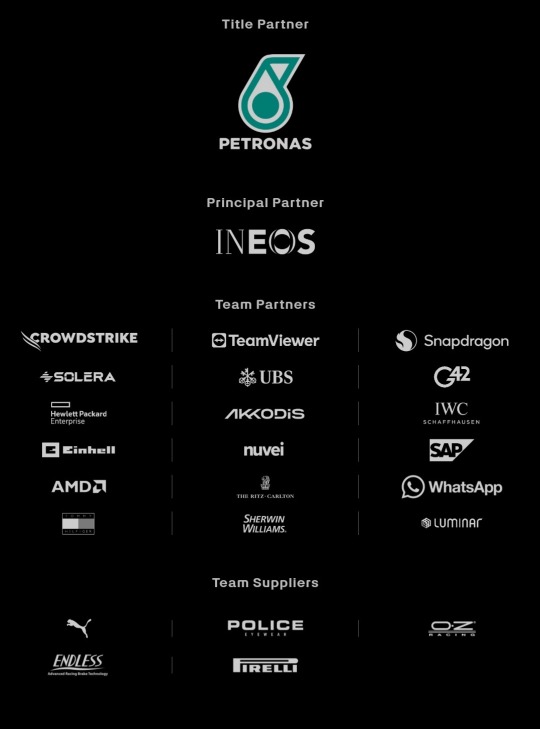
New sponsors: Whatsapp, Luminar (American tech company), SAP (German software company), nuvei (Canadian credit card services), Sherwin Williams (American painting company) 2024 data last update: 2024/02/14
Old sponsors that left: Monster Energy, Pure Storage (American technology company), fastly (American cloud computing services), Axalta (American painting company), Eight sleep (American mattresses company) 2023 data last update: 2023/01/07
Oracle Red Bull Racing F1 Team:
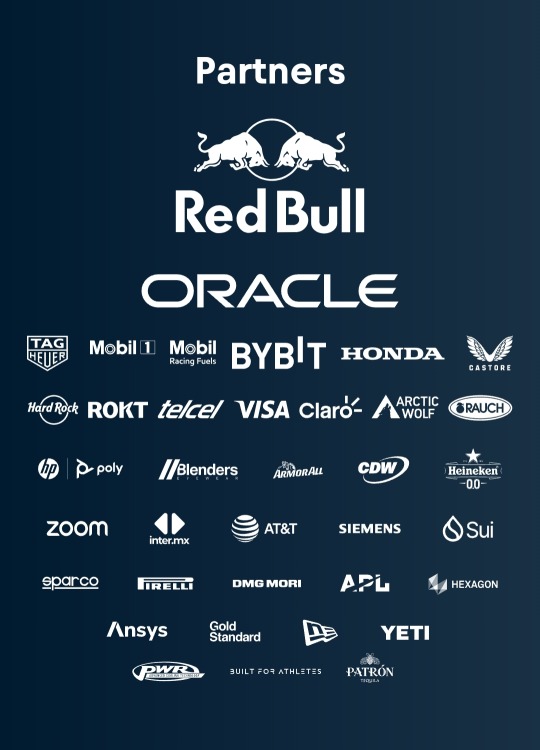
New sponsors: Yeti (American cooler manufacturer, joined later in 2023), APL (American footwear/athletic apparel manufacturer, joined later in 2023), CDW (American IT company, joined later in 2023), Sui (American tech app by Mysten Labs, joined later in 2023), Patron Tequila (Mexican alcoholic beverages company, joined later in 2023) 2024 data last update: 2024/02/15
Old sponsors that left: CashApp, Walmart, Therabody (American wellness technology company), Ocean Bottle (Norwegian reusable bottle manufacturer), PokerStars (Costa Rican gambling site), Alpha Tauri (? no info if they're official partners or not but Austrian clothing company made by Red Bull), BMC (Switzerland bicycle/cycling manufacturer), Esso (American fuel company, subsidiary of ExxonMobil), Hewlett Packard Enterprise (American technology company) 2023 data last update: 2023/03/07
More: Esso is a subsidiary of Mobil so there's possibility they merged or something
Scuderia Ferrari:
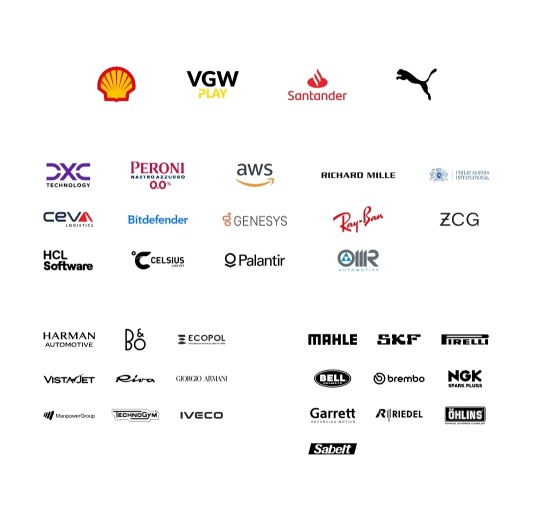
New sponsors: VGW Play (Australian tech game company, joined later in 2023), DXC Technology (American IT company, joined later in 2023), Peroni (Italian brewing company), Z Capital Group/ZCG (American private asset management/merchant bank company), Celsius (Swedish energy drink manufacturer) 2024 data last update: 2024/02/15
Old sponsors that left: Mission Winnow (American content lab by Phillip Morris International aka Marlboro), Estrella Garcia (Spanish alcoholic beverages manufacturer), Frecciarossa (Italian high speed train company) 2023 data last update: 2023/02/16
More: Mission Winnow is a part of Phillip Morris International. They are no longer listed as team sponsor but PMI is listed instead.
(starting here, 2023 data last update is 2023/02/23 and 2024 data last update is 2024/02/15)
McLaren F1 Team: (Only McLaren RACING's data is available idk if some of these are XE/FE team partners but anw..)
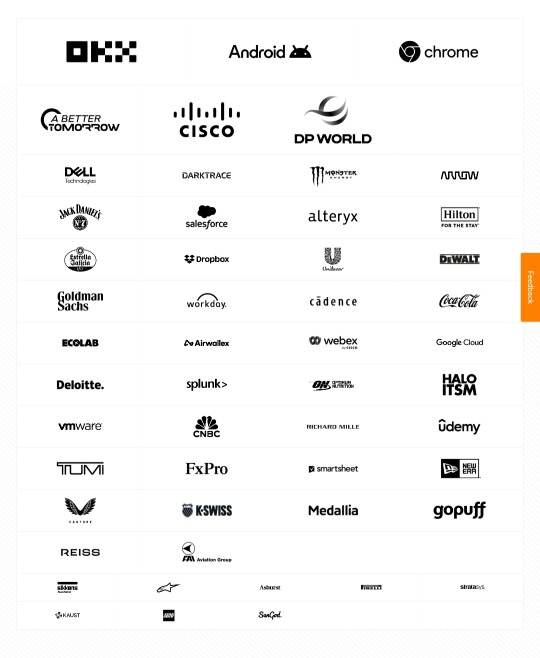
New sponsors: Monster Energy, Salesforce (American cloud based software company, joined later in 2023), Estrella Garcia (Spanish alcoholic beverages manufacturer), Dropbox (American file hosting company), Workday (American system software company, joined later in 2023), Ecolab (American water purification/hygiene company), Airwallex (Australian financial tech company), Optimum Nutrition (American nutritional supplement manufacturer), Halo ITSM (American software company, joined later in 2023), Udemy (American educational tech company, joined later in 2023), New Era (American cap manufacturer, joined in 2023), K-Swiss (American shoes manufacturer, joined later in 2023), Alpinestars (Italian motorsports safety equipment manufacturer)
Old sponsors that left: DP World (Emirati logistics company), EasyPost (American shipping API company), Immersive Labs (UK cybersecurity training company?), Logitech, Mind (UK mental health charity), PartyCasino (UK? online casino site), PartyPoker (American? gambling site), Sparco (Italian auto part & accessory manufacturer), Tezos (Switzerland crypto company)
Aston Martin Aramco F1 Team:

New sponsors: Valvoline (American retail automotives service company, joined later in 2023), NexGen (Canadian sustainable? fuel company), Banco Master (Brazilian digital banking platform, joined later in 2023), ServiceNow (American software company, joined later in 2023), Regent Seven Seas Cruise, Wolfgang Puck (Austrian-American chef and restaurant owner, joined later in 2023), Financial Times (British business newspaper), OMP (Italian racing safety equipment manufacturer), stichd (Netherlands fashion & apparel manufacturer)
Old sponsors that left: Alpinestars (Italian motorsports safety equipment manufacturer), crypto.com (Singaporean cryptocurrency company), ebb3 (UK? software company), Pelmark (UK fashion and apparel manufacturer), Peroni (Italian brewing company), Porto Seguro (Brazilian insurance company), Socios (Malta's blockchain-based platform), XP (Brazilian investment company)
Stake F1 Team (prev. Alfa Romeo):
???? Can't found their website (might be geoblocked in my country???)
BWT Alpine F1 Team:
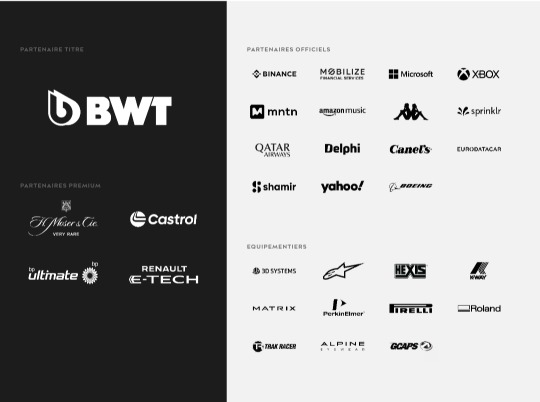
New sponsors: MNTN (American software company), H. Moser & Cie (Switzerland watch manufacturer), Amazon Music
Old sponsors that left: Bell & Ross (French watch company), Ecowatt (??? afaik French less-energy smthn smthn company), Elysium (French? American? Software company), KX (UK software company), Plug (American electrical equipment manufacturing company)
Visa CashApp RB F1 Team (prev. Scuderia Alpha Tauri):
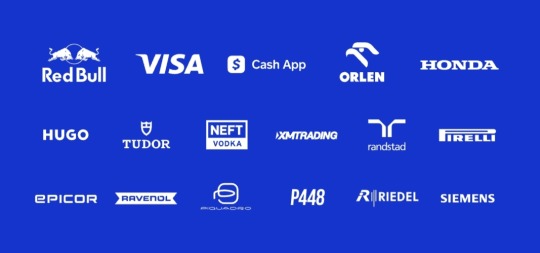
New Sponsors: Visa, CashApp, Hugo Boss, Tudor, Neft Vodka (Austrian alcoholic beverages company), Piquadro (Italian luxury bag manufacturer)
Old sponsors that left: Buzz (?), Carl Friedrik (UK travel goods manufacturer), Flex Box (Hongkong? shipping containers manufacturer), GMG (Emirati global wellbeing company), RapidAPI (American API company)
Haas F1 Team:

New sponsors: New Era (American cap manufacturer, joined later in 2023)
Old sponsors that left: Hantec Markets (Hongkong capital markets company), OpenSea (American NFT/Crypto company)
Williams Racing:


New sponsors: Komatsu, MyProtein (British bodybuilding supplement), Kraken (American crypto company, joined later in 2023), VAST Data (American tech company), Ingenuity Commerce (UK e-commerce platform), Puma (joined later in 2023)
Old sponsors that left: Acronis (Swiss software company), Bremont (British watch manufacturer), Dtex Systems (American? cybersecurity company), Financial Times (British business newspaper), Jumeirah Hotels & Resorts, KX (UK software company), OMP (Italian racing safety equipment manufacturer), PPG (American painting manufacturer), Umbro (English sports equipment manufacturer), Zeiss (German opticals/optometrics manufacturing company)
#mercedes amg petronas#red bull racing#scuderia ferrari#visa cash app rb#haas f1 team#mclaren f1#aston martin#alpine f1#williams racing#stake f1 team#f1#ari's rant#sponsor talks
42 notes
·
View notes
Text
GothamNAV
You know what would be cool in Gotham? A specialized navigation software/app that takes into acount what is going on in the city. Imagine Google Maps but with rogue updates.
- Take the next right onto 5th street to avoid joker toxin on Park Row. - The drive time increases by five minutes due to an explosion on 14th Street. - This route requires a gas mask for safe travel. - Riddler was sighted along your route. Do you want to adjust to avoid this encounter?
I imagine there is en extensive settings menu.
Avoid Rogues (ON/OFF) Avoid Bats (ON/OFF) Avoid Police (ON/OFF) Avoid Gas releases (ON/OFF) (we recommend to enable this function if your gas mask is damaged) Accessible Routes only (ON/OFF) Gang Territory Overlay (ON/OFF) Avoid Territory of ( ) Red Hood ( ) Black Mask ( ) [...]
And when you ask it to navigate you somewhere, you get *Options*.
- safest route (avoid rogue activity, vigilantes, police and environmental hazards) - fastest route (possibly dangerous paths that get you to your destination quickly) - scenic route (leads through the proximity of active events while keeping some distance)
I imagine they work with the police and the bats (mainly Oracle, obviously), because that way they also keep civilians out of the way.
I think they would start as a project from some computer sciences students from Gotham University that get annoyed about always having to listen to their navigation going "please go straight ahead" when they can see the fear toxin clouding that street, but over time they make it into a full on service. It's free, they get funding from Wayne Enterprises so that its available for everyone. They figure out ways to make it more accessible for different disabilities, improve the integration of the public transport system and even integrate a feature to directly navigate everyone to shelters if some major catastrophe hits. Everyone in Gotham uses it, so if you see a stray car driving down a street everyone else is avoiding, they are surely from out of town.
9 notes
·
View notes
Text
I’ve also been working on Dragon Path Life! Below is an excerpt.
8.Cloud
Droplets form a Cloud. starlight. late Droplets, sorry.
a Droplet trusts a Cloud, without worry. in the end, starlight.
a Cloud trusts a Droplet. keep going for starlight.
a Droplet trusts an Evil Cloud.
a Droplet trusts a Droplet. keep going for starlight.
a Cloud eats a Fool. starlight.
a Droplet without a Cloud, sorry.
*Dragon Path Life (DPL) is a future-past translation of the I Ching. The I Ching might be one of the oldest surviving divinatory systems. It can be consulted by the use of coins (or apps). What you see above are a few of the many possible outcomes. So you ask a question, and the Void answers.
**example. you find a new friend. but they do something weird. so you consult the oracle and ask ‘can i trust this new friend?’ the Void answers:
-> if the Void answers [8.3], then you should not trust the new friend.
-> if the Void answers [8.4], then you should trust the new friend.
2 notes
·
View notes
Text
A wealthy entrepreneur based in a western US state will be making an offer to buy TikTok for around $50 billion on Wednesday, The Post can reveal.
Larry Ellison had been floated as a potential buyer earlier this year for the social media app, which is owned by the Chinese firm ByteDance, and his company Oracle, which is based in Austin, Texas, already serves as a cloud computing partner for TikTok.
Other potential buyers have included Tesla and SpaceX founder Elon Musk as well as billionaire Frank McCourt and “Shark Tank” star Kevin O’Leary, who have said they have $20 billion in commitments as part of a plan to buy the TikTok brand and rebuild its algorithm from scratch on US soil.
President Trump had pledged to “save TikTok” before taking office and signed an executive order on Day One granting a 75-day reprieve from a law signed by former President Joe Biden that mandated the qualified divestment of the app from its Chinese parent company.
“I met with the owners of TikTok, the big owners, it’s worthless if it doesn’t get a permit,” he told reporters at the White House in January during a $500 billion AI infrastructure project announcement involving Oracle, Softbank and OpenAI.
“It’s worth like a trillion dollars,” the president added. “So what I’m thinking about saying to somebody is, ‘Buy it and give half to the United States of America, and we’ll give you the permit,’ and they’ll have a great partner.”
At the time, Trump said he was open to Ellison purchasing TikTok.
3 notes
·
View notes
Text
Dan Milmo at The Guardian:
TikTok is back in the US – but Apple and Google are not sure if it should be.
The short video app has yet to appear on the tech companies’ app stores, reflecting an unease about the White House executive order that has given TikTok the confidence to resume operations after temporarily shuttering the service on 18 January. Apple and Google do not appear to agree. The legislation forbade companies from distributing, maintaining or updating TikTok – for instance, selling it on an app store – after a deadline of 19 January. But the executive order, signed within hours of Donald Trump’s return to the White House, suspended for 75 days enforcement of an act that demanded the Beijing-based owner of TikTok, ByteDance, sell the app’s US operation or face a de facto ban. The order seeks to reassure companies that work with TikTok that they will not be prosecuted for keeping the social media app on US users’ smartphone screens. It also instructs the attorney general – who leads the Department of Justice (DoJ) – to issue a letter reassuring those entities that the law has not been violated and there is no liability for their conduct. Nonetheless, Apple and Google have taken TikTok off their stores, meaning US smartphone users cannot download it. In the rest of the world, the app is free to access as before. In China, ByteDance runs a sister app, Douyin. Oracle, the cloud computing provider that delivers the app’s content, has not pulled the plug in the US. Larry Ellison, Oracle’s founder and the world’s fourth richest person, with a $209bn (£167bn) fortune, has been suggested by Trump as a potential buyer of TikTok. Indeed, Ellison was present at a press conference last week where Trump suggested he buy it, saying it sounded like a “good deal”. On Saturday NPR reported that Trump was working on a deal to buy TikTok’s global operations that involved Oracle, although the president then pushed back on that scenario, saying he was not in talks with the company.
While TikTok is back operating in the USA, the app is not back in app stores such as Google Play Store and Apple App Store, which means that TikTok cannot be downloaded or updated from an app store at this time.
2 notes
·
View notes
Text
no tracking app, no calendar, I'm out here predicting when my period starts like an ancient oracle predicting the end of the world from the shape of the clouds
5 notes
·
View notes
Text
What is the best IFRS software
Best International Financial Reporting Standards (IFRS) software because the choice of software depends on the specific needs and requirements of the organization. Different companies may have distinct preferences based on factors such as size, industry, complexity of financial reporting, and integration capabilities with existing systems.
However, there are several reputable software solutions that are commonly used for IFRS reporting and compliance. Keep in mind that the landscape might have changed, and new solutions may have emerged since my last update.
Workiva:
Workiva offers cloud-based solutions for finance, compliance, and data management. It is known for its collaborative and workflow management features.
Tagetik (owned by Wolters Kluwer):
Tagetik provides a unified platform for financial performance management, including IFRS reporting. It is designed to streamline funds processes and improve compliance.
Oracle Financial Services Analytical Applications (OFSAA):
Oracle's OFSAA suite includes modules for various budgetary functions, including regulatory info. It is designed to help wealthy institutions comply with IFRS and other reporting standards.
SAP S/4HANA:
SAP's ERP solution, S/4HANA, includes financial modules that can support IFRS. SAP is widely used in large enterprises across various industries.
Datar ails:
Data Rails offers a platform that automates funds reporting, budgeting, and forecasting. It is designed to improve the accuracy and efficiency of income processes.
Hubble (by insight software):
Hubble is an integrated suite of performance management apps. It provides solutions for financial reporting, analytics, and planning.
OneStream Software:
OneStream offers a unified CPM (Corporate Performance Management) platform that includes solutions for financial consolidation and planning, supporting IFRS compliance.
When choosing an IFRS software solution, it's essential to consider factors such as the organization's specific information needs, budget, scalability, ease of use, and integration capabilities with existing systems. Additionally, staying informed about updates and reviews in the financial software market is crucial to ensuring that the chosen solution meets the latest standards and regulations.
2 notes
·
View notes
Text
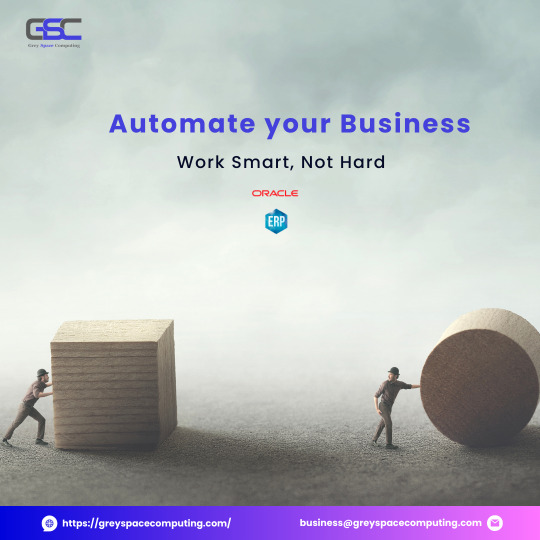
Transform the way you do business! 🚀 Our ERP application simplifies operations, making work effortless. 💼✨ Say goodbye to complexity and hello to efficiency. Ready to streamline your business? Let's make it happen together! 🌐 Website: https://greyspacecomputing.com/oracle-erp-solution/ 📧 Email: [email protected] 📱 Phone: +91-98602 56990 #BusinessTransformation #EffortlessOperations #ERPRevolution #OracleERP #Greyspacecomputing #oracleerp #cloudsolutions #clouderp #cloudapplications #oraclepartnerindonesia #oraclepartner #odi #optimadatainternasional #equinetechnologiesgroup #odilife #oracleodi #oracleerpcloud #stronger #faster #oraclehcm #oraclehcmcloud #oracleapplicationspartner #oraclecx #worklifeinodi #oraclecxcloud #reater #workato #accounting #technology #erpcloud #netsuite #oracle #erp #innovation
1 note
·
View note
Text
Top 10 ERP Software for Engineering Industry
In the contemporary and dynamic commercial environment, the engineering sector in India is confronted with a diverse range of obstacles, including intense competition, increasing client expectations, intricate project administration, and resource allocation optimisation. In the contemporary era of technology, the utilisation of Enterprise Resource Planning (ERP) software has become an essential and irreplaceable instrument for engineering firms aiming to optimise their operational processes, improve productivity, and foster long-term and sustainable expansion. Boost your engineering company's efficiency with cutting-edge ERP software – STERP software offered by STERP (Shanti Technology) – one of the most trusted firms offering ERP software for engineering companies in Mumbai. Take the first step towards success today with STERP!
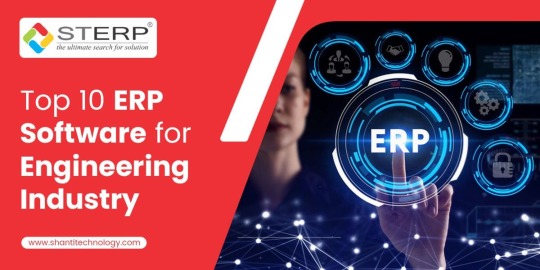
This blog article offers a comprehensive examination of the ten leading enterprise resource planning (ERP) software packages specifically designed to cater to the distinct requirements of the engineering sector in India. The aim is to assist organisations in making well-informed choices that will contribute to their future success.
· STERP Software:
STERP Software is a cutting-edge ERP solution offering an array of features to streamline business operations. It excels in location tracking, task management, and mobile user visit reports. Additionally, it enables seamless tracking of finished goods progress and efficient document management. ISO audit reports and vendor ratings ensure compliance and supplier assessment. The dynamic dashboard provides real-time insights, while multi-currency support facilitates global transactions.
The export documents feature simplifies international trade, and auto-email & SMS integration enhances communication. Quotation lost analysis ratio aids in optimizing sales strategies. Depreciation calculation and auto JV streamline accounting. Moreover, it's Android & iOS mobile app enables easy on-the-go access, including component process tracking.
· Tally.ERP 9:
Tally.ERP 9 is a highly renowned and extensively utilised enterprise resource planning (ERP) software in India, serving a diverse range of businesses, including engineering enterprises, irrespective of their scale or magnitude. Tally.ERP 9 offers comprehensive financial management, inventory control, and taxation modules that enable engineering organisations to adhere to Indian accounting rules and effectively handle financial data management.
· Oracle NetSuite:
Oracle NetSuite is a cloud-based enterprise resource planning (ERP) software that offers a cohesive platform, encompassing ERP, customer relationship management (CRM), and electronic commerce (eCommerce) capabilities. The software's adaptability and capacity to accommodate the needs of engineering businesses of varying sizes in India allow for the optimisation of operations and the acquisition of significant knowledge regarding their business procedures.
· Microsoft Dynamics 365 ERP:
Microsoft Dynamics 365 is a multifaceted enterprise resource planning (ERP) solution that encompasses several functionalities like financial management, supply chain operations, and project accounting. By incorporating localization capabilities specifically designed for India, the software enables engineering organisations to effectively streamline their processes, adhere to regulatory standards, and improve overall client satisfaction.
· Ramco ERP:
The Ramco ERP system has been specifically developed to cater to the distinct needs and demands of the engineering sector within the Indian market. The inclusion of modules pertaining to project management, asset management, and production planning facilitates the attainment of operational excellence and the stimulation of growth within engineering enterprises.
Empower your engineering firm with advanced ERP tools offered by STERP – one of the renowned ERP solution providers in Mumbai. Get a free consultation to discover how!
· EPPS ERP:
The EPPS ERP is a software solution originating from India that has been specifically designed to cater to the needs of the engineering industry. The EPPS ERP system offers a comprehensive range of modules that encompass several aspects of project management, including project planning, procurement, and quality control. By leveraging these modules, firms can effectively streamline their project management processes while upholding stringent quality standards.
· Marg ERP 9+:
Marg ERP 9+ is widely favoured among small and medium-sized engineering enterprises in India. The programme provides a wide range of capabilities, encompassing inventory management, order processing, and adherence to GST legislation, so facilitating operational efficiency and ensuring compliance with local legal requirements for enterprises.
· Infor CloudSuite Industrial (SyteLine):
Infor CloudSuite Industrial, previously recognised as SyteLine, is a comprehensive enterprise resource planning (ERP) solution that specifically caters to the needs of process manufacturing and job shop industries. Its suitability for engineering firms in India lies in its ability to effectively manage different production requirements.
· Focus i:
Focus i is an ERP software that has been designed in India specifically to address the distinct requirements of the engineering industry in the country. Focus i is a software solution that offers several functionalities, including project management, production planning, and HR management. This comprehensive suite of tools enables engineering organisations to enhance their operational efficiency and financial performance.
Optimize your engineering projects and increase profitability. Get ERP solutions offered by top ERP for manufacturing company in Mumbai – STERP (Shanti Technology).
· Reach ERP:
Reach ERP is a nascent participant in the Indian enterprise resource planning (ERP) industry, specifically tailored to cater to the needs of small and medium-sized engineering enterprises. The cloud-based design of this system, in conjunction with its various capabilities such as inventory control, order management, and financial accounting, facilitates efficient operational administration for organisations.
Final Thoughts:
The pursuit of efficiency, innovation, and sustainable growth holds significant importance in India's engineering business. The adoption of digital transformation within the industry has led to the recognition of ERP software as a crucial facilitator. This software plays a significant role in assisting engineering companies in optimising their operations, enhancing the efficient allocation of resources, and ultimately improving customer satisfaction. The aforementioned list comprises the top 10 enterprise resource planning (ERP) software systems that are tailored to address the unique requirements of the engineering sector in India. These software solutions offer a wide range of comprehensive features and functionalities, specifically designed to effectively address the many difficulties and opportunities prevalent in the market.
When making a decision on the choice of an Enterprise Resource Planning (ERP) system, engineering businesses should take into account many variables like scalability, localization capabilities, simplicity of integration, and vendor support. Gain a competitive edge in Mumbai's engineering sector - Implement effective ERP solution offered by STERP (Shanti Technology) – one of the distinct ERP software providers in Mumbai! The use of Enterprise Resource Planning (ERP) technology represents a strategic decision that holds the potential to bring about dramatic changes within the engineering industry in India.
#ERP software for engineering companies in Mumbai#ERP solution providers in Mumbai#ERP for manufacturing company in Mumbai#ERP software providers in Mumbai#ERP software#technology#ERP system#cloud ERP#ERP solutions#manufacturer#engineering#business process#management software#business analytics#engineering industry
5 notes
·
View notes
Text

Top Cloud Migration Services.
Cloud Migration services To move your data and apps to the Oracle Cloud, a more safe and productive environment is available to you with astute cloud solutions and services.
1 note
·
View note
Text
Cloud Database and DBaaS Market Empowers Enterprises with Real-Time Analytics Solutions
Cloud Database And DBaaS Market was valued at USD 17.51 billion in 2023 and is expected to reach USD 77.65 billion by 2032, growing at a CAGR of 18.07% from 2024-2032.
Cloud Database and DBaaS Market is witnessing rapid adoption as organizations shift from traditional on-premise databases to flexible, scalable, and cost-effective cloud-based solutions. Businesses across various industries are embracing Database-as-a-Service (DBaaS) to accelerate digital transformation, enhance performance, and improve data management across distributed environments.
U.S. Leads the Global Shift to Cloud Database and DBaaS Solutions
Cloud Database and DBaaS Market continues to grow amid rising data volumes, increased demand for real-time analytics, and the expanding use of AI and IoT. Enterprises are opting for managed database services to reduce operational burden, improve agility, and maintain business continuity in dynamic environments.
Get Sample Copy of This Report: https://www.snsinsider.com/sample-request/6586
Market Keyplayers:
Google LLC (Cloud SQL, BigQuery)
Nutanix (Era, Nutanix Database Service)
Oracle Corporation (Autonomous Database, Exadata Cloud Service)
IBM Corporation (Db2 on Cloud, Cloudant)
SAP SE (HANA Cloud, Data Intelligence)
Amazon Web Services, Inc. (RDS, Aurora)
Alibaba Cloud (ApsaraDB for RDS, ApsaraDB for MongoDB)
MongoDB, Inc. (Atlas, Enterprise Advanced)
Microsoft Corporation (Azure SQL Database, Cosmos DB)
Teradata (VantageCloud, ClearScape Analytics)
Ninox (Cloud Database, App Builder)
DataStax (Astra DB, Enterprise)
EnterpriseDB Corporation (Postgres Cloud Database, BigAnimal)
Rackspace Technology, Inc. (Managed Database Services, Cloud Databases for MySQL)
DigitalOcean, Inc. (Managed Databases, App Platform)
IDEMIA (IDway Cloud Services, Digital Identity Platform)
NEC Corporation (Cloud IaaS, the WISE Data Platform)
Thales Group (CipherTrust Cloud Key Manager, Data Protection on Demand)
Market Analysis
The Cloud Database and DBaaS Market is being propelled by the need for scalable infrastructure and advanced analytics capabilities. Businesses are moving to cloud-native architectures, enabling faster deployments, lower capital expenditure, and seamless integration with third-party tools. The U.S. dominates the market due to its mature tech ecosystem, while Europe follows with increasing investments in digital infrastructure and stringent data protection mandates that drive secure cloud adoption.
Cloud DBaaS platforms are offering multi-model databases, enhanced backup solutions, and robust failover mechanisms. Enterprises are particularly drawn to platforms that support hybrid and multi-cloud strategies, giving them flexibility and control over critical data operations.
Market Trends
Growing adoption of hybrid and multi-cloud database architectures
Increased demand for serverless database solutions
Integration of AI/ML capabilities into cloud database platforms
Expansion of real-time data processing and streaming analytics
Enhanced security and compliance features for GDPR and other regulations
Rise of open-source cloud databases and community-supported platforms
DBaaS providers offering vertical-specific solutions (finance, healthcare, etc.)
Market Scope
The Cloud Database and DBaaS Market is reshaping how businesses store, manage, and scale data. The demand for always-on, globally accessible databases is pushing vendors to develop smarter, faster, and more resilient solutions.
Seamless scalability across enterprise workloads
Managed services reducing internal IT complexity
Cross-region replication for disaster recovery
Auto-scaling and self-healing infrastructure
Centralized dashboards for monitoring and optimization
Enhanced developer agility with DevOps integration
Access Complete Report: https://www.snsinsider.com/reports/cloud-database-and-dbaas-market-6586
Forecast Outlook
The market is expected to maintain its upward trajectory as businesses increasingly prioritize speed, flexibility, and resilience in data operations. With cloud-native development becoming standard, DBaaS adoption is likely to accelerate among both large enterprises and mid-sized companies. Future advancements will be driven by AI-powered automation, zero-downtime migrations, and further convergence of data storage and analytics functions. The U.S. and Europe will remain key growth zones, supported by cloud innovation and evolving data regulations.
Conclusion
The Cloud Database and DBaaS Market is no longer a future trend—it’s a present-day essential. As organizations embrace digital-first strategies, the demand for scalable, secure, and intelligent database solutions is reshaping global IT infrastructure. For companies aiming to lead in agility and innovation, investing in DBaaS is a decisive move toward operational excellence and data-driven growth.
About Us:
SNS Insider is one of the leading market research and consulting agencies that dominates the market research industry globally. Our company's aim is to give clients the knowledge they require in order to function in changing circumstances. In order to give you current, accurate market data, consumer insights, and opinions so that you can make decisions with confidence, we employ a variety of techniques, including surveys, video talks, and focus groups around the world.
Contact Us:
Jagney Dave - Vice President of Client Engagement
Phone: +1-315 636 4242 (US) | +44- 20 3290 5010 (UK)
Mail us: [email protected]
0 notes
Text
Open Banking Market Growth, Size & Forecast 2025-2030
The Global Open Banking Market size was valued at around USD 31.54 billion in 2024 and is projected to reach USD 136.13 billion by 2030. Along with this, the market is estimated to grow at a CAGR of around 27.60 % during the forecast period, i.e., 2025-30.
Open Banking Market Driver:
Surging Government Support to Augment the Market Growth – In an era of globalization, governments worldwide recognize the significance of fostering connections between their financial institutions & consumers and their international counterparts. This has led countries like the UK, Mexico, and the US to actively endorse the adoption of open banking services, simplifying cross-border financial transactions & enriching global trade relationships. Moreover, over the past decade, North American and European nations have taken a proactive stance in democratizing access to financial products & services.
Notably, the European Banking Authority introduced the Payment Services Directive Two (PSD2) in 2015, formally inaugurating the era of open banking. Subsequently, the UK's Competition and Markets Authority (CMA) issued progressive guidelines mandating banks to embrace open banking practices by 2018. These regulatory mandates compel banks to open up their closely held financial data to third-party providers, an initiative that has encouraged a growing number of entities to participate, further driving the Global Open Banking Market.
Download a free sample copy of the Report: https://www.marknteladvisors.com/query/request-sample/open-banking-market.html
Key Market Reports Highlights
Market Dimensions & Projections
Pricing Evaluation
Recent Strategic Moves by Companies
Primary Stakeholders
Import/Export Trend Analysis
Competitive Landscape Assessment
Emerging Opportunities
Market Trends and Indicators
*Reports Delivery Format - Market research studies from MarkNtel Advisors are offered in PDF, Excel and PowerPoint formats. Within 24 hours of the payment being successfully received, the report will be sent to your email address.
Browse Full Report including (TOC+ List of Table and Figures) : https://www.marknteladvisors.com/research-library/open-banking-market.html
Open Banking Market Segmentation:
The market report categorizes the market based on different segments and geographical analysis.
Study Timeline:
-Base Year: 2024
-Historical Period: 2020 to 2023
-Forecast Period: 2025 to 2030
By Service
Retail Banking
Aggregation & Financial Management - Market Size & Forecast 2020-2030F, USD Billion
Credit Risk Decisioning- Market Size & Forecast 2020-2030F, USD Billion
Payments- Market Size & Forecast 2020-2030F, USD Billion
Origination & Onboarding- Market Size & Forecast 2020-2030F, USD Billion
Others
Corporate Banking
Corporate Treasury- Market Size & Forecast 2020-2030F, USD Billion
Financial Management- Market Size & Forecast 2020-2030F, USD Billion
Credit Decisioning- Market Size & Forecast 2020-2030F, USD Billion
Payments- Market Size & Forecast 2020-2030F, USD Billion
Value Added Services- Market Size & Forecast 2020-2030F, USD Billion
Others
Capital Markets
Others
By Distribution Channel
Bank Channel- Market Size & Forecast 2020-2030F, USD Billion
App Market- Market Size & Forecast 2020-2030F, USD Billion
Distributors- Market Size & Forecast 2020-2030F, USD Billion
Aggregators- Market Size & Forecast 2020-2030F, USD Billion
By Deployment
On-premise- Market Size & Forecast 2020-2030F, USD Billion
Cloud- Market Size & Forecast 2020-2030F, USD Billion
Hybrid- Market Size & Forecast 2020-2030F, USD Billion
By Region
North America
South America
Europe
The Middle East & Africa
Asia-Pacific
Competitive Landscape
With strategic initiatives, such as mergers, collaborations, and acquisitions, the leading market companies, including - Finleap, Revolut Ltd., Tink AB, Salesforce Inc., Worldline S.A., Tata Consultancy Services Limited, Capgemini, Oracle, Finicity (Mastercard), Jack Henry & Associates, Inc., Finastra, Payments, Virtusa Corp, Plaid Inc, etc, and others
Have questions? Our consultant is ready to assist: https://www.marknteladvisors.com/query/talk-to-our-consultant/open-banking-market.html
Data-Driven Insights Backed by Proven Research
We follow a tried-and-tested research methodology that blends top-down and bottom-up approaches to deliver highly accurate market insights. Every report is powered by data triangulation, ensuring well-rounded and validated findings.
From smart sample selection and reliable data collection to in-depth analysis and precise forecasting, our process is designed to minimize error and maximize impact.
About Us –
MarkNtel Advisors is a leading consulting, data analytics, and market research firm that provides an extensive range of strategic reports on diverse industry verticals. We being a qualitative & quantitative research company, strive to deliver data to a substantial & varied client base, including multinational corporations, financial institutions, governments, and individuals, among others.
We have our existence across the market for many years and have conducted multi-industry research across 80+ countries, spreading our reach across numerous regions like America, Asia-Pacific, Europe, the Middle East & Africa, etc., and many countries across the regional scale, namely, the US, India, the Netherlands, Saudi Arabia, the UAE, Brazil, and several others.
Contact Us
MarkNtel Advisors
Email: [email protected]
Website: www.marknteladvisors.com
Latest Press Release - https://www.marknteladvisors.com/press-release
0 notes
Text
How Medical Software Companies Are Transforming Healthcare Operations
In the digital age, the healthcare sector is experiencing rapid technological transformation. Central to this change are medical software companies—tech-driven firms that develop innovative solutions to streamline, automate, and enhance the delivery of medical services. From electronic health records to patient portals and AI-driven diagnostics, these companies are driving efficiency, accuracy, and accessibility in healthcare across the globe.
With the increasing demand for better healthcare infrastructure, medical software companies are stepping up to fill critical gaps. Whether it’s in rural India or urban America, these solutions are helping hospitals and clinics move from outdated manual processes to modern, cloud-based systems that offer real-time insights and collaboration.

What Do Medical Software Companies Offer?
Medical software companies develop a broad range of digital tools specifically designed for healthcare professionals, institutions, and patients.
Their offerings include:
Electronic Medical Records (EMR) and Electronic Health Records (EHR)
Hospital Management Systems (HMS)
Telemedicine and virtual consultation platforms
Medical billing and revenue cycle management software
AI-based diagnostic and imaging tools
Inventory and pharmacy management systems
Mobile health (mHealth) apps for patients
These solutions ensure accurate data handling, faster services, and regulatory compliance, which are vital in a sensitive and critical industry like healthcare.
Why Medical Software is Crucial Today
Rising Healthcare Demand The growing population, increasing chronic illnesses, and demand for better health services have overwhelmed traditional healthcare systems. Medical software helps bridge the gap by enabling automation and digital workflows.
Data-Driven Decisions Medical software companies build systems that can store, analyze, and retrieve vast amounts of patient data. This facilitates better decision-making, personalized treatment plans, and predictive healthcare.
Remote Care Access With telemedicine, patients in remote areas can now access top doctors without traveling. Medical software enables secure video consultations, prescriptions, and follow-ups online.
Regulatory Compliance Healthcare regulations like HIPAA in the U.S. and the Clinical Establishments Act in India require strict data protection. Medical software ensures adherence through built-in privacy features and audit trails.
Top Features Offered by Leading Medical Software Companies
Cloud-Based Accessibility: Enables real-time updates and data sharing between departments or clinics.
Role-Based Access Control: Ensures sensitive data is only accessible to authorized personnel.
Automated Scheduling and Reminders: Reduces missed appointments and increases operational efficiency.
Billing Integration: Simplifies the process of insurance claims, payments, and reimbursements.
Custom Dashboards: Offers administrators and doctors a personalized view of patient records, financials, and analytics.
Noteworthy Global Medical Software Companies
Epic Systems Corporation: One of the pioneers in EHR systems, widely used in the U.S.
Cerner Corporation (Oracle Health): Offers integrated healthcare software and cloud-based analytics.
Athenahealth: Known for its user-friendly cloud solutions and revenue cycle management tools.
GE Healthcare: Delivers imaging software and hospital management systems with AI integration.
Allscripts: Provides open, connected platforms for small and large-scale practices.
Emerging Indian Medical Software Companies
India’s growing health tech ecosystem has given rise to several innovative software firms:
Practo: Offers clinic management, EHR, online consultations, and appointment booking solutions.
Attune Technologies: Specializes in cloud-based HIS and diagnostic lab software for hospitals.
MocDoc: Provides a full suite of software for hospitals, labs, and pharmacies.
CrelioHealth: Focuses on diagnostic and pathology lab software with mobile app support.
KareXpert: Offers plug-and-play digital health platforms for multi-specialty hospitals.
These companies are not only making healthcare more accessible but are also helping digitize even small and medium medical practices across India.
How to Select the Right Medical Software Company
Understand Your Requirements: A clinic may need an EMR, while a hospital may require a full-scale HMS with integrated departments.
Check for Certifications and Compliance: Ensure the software follows national and international data protection standards.
Evaluate User Experience: The interface should be easy for doctors, nurses, and admin staff to use.
Look at Support and Training: A good vendor offers onboarding, live support, and system updates.
Scalability: Choose software that grows with your business, offering upgrades and additional modules.
The Future of Medical Software
Medical software companies are increasingly adopting new technologies to remain ahead:
Artificial Intelligence (AI): Helps in predictive diagnostics, risk analysis, and medical imaging.
Blockchain: Ensures data security and patient record integrity.
Internet of Medical Things (IoMT): Connects medical devices and syncs them with patient data systems.
Voice Recognition: Doctors can dictate notes and prescriptions, reducing paperwork time.
Mobile Health (mHealth): Patients are empowered with apps to monitor vitals, schedule appointments, and access prescriptions.
Conclusion
Medical software companies are no longer just service providers—they are vital partners in the healthcare journey. By digitizing patient records, simplifying complex operations, and enabling remote care, they are empowering both providers and patients.
In a world where every second counts, especially in healthcare, the role of software in saving lives and ensuring efficiency cannot be overstated. As the healthcare landscape evolves, medical software will continue to be a cornerstone of accessible, affordable, and effective medical care.
Whether you're a healthcare entrepreneur, a hospital administrator, or a medical practitioner, partnering with the right medical software company can revolutionize how you deliver care.
0 notes